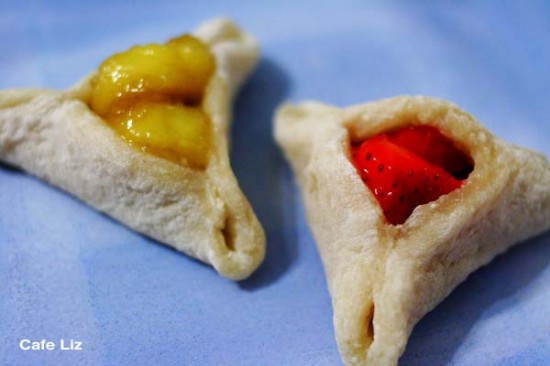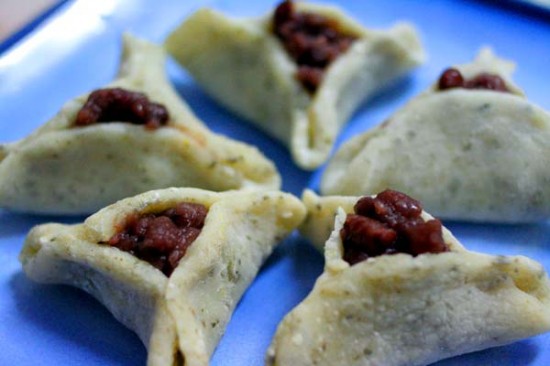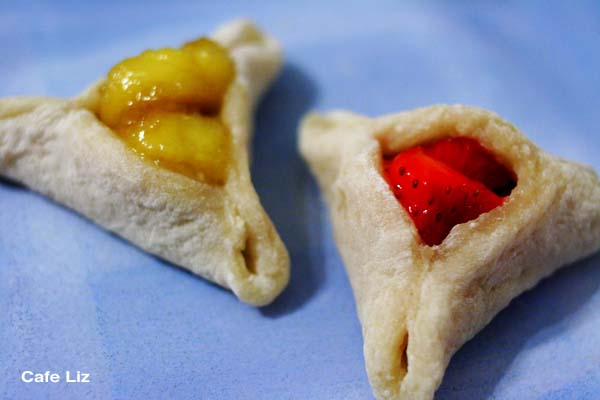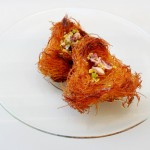
When we were in Japan, one of the things we ate on a daily basis was mochi — the squishy, sticky, gooey sweetened rice snack, generally filled with azuki beans. That was one of the things that we missed, since you can’t get it anywhere in Israel, so lo and behold, what did we bring back from our last trip to the U.S.? Mochi from Chinatown.
Anyway, lucky for us, I’ve since learned that mochi is pretty easy to make. The word mochi refers generally to a sticky rice snack. The rounded, filled dumplings we found at the corner grocery store and enjoyed on a daily basis are called daifuku, while the triangular cinnamon treats in Kyoto are more accurately known as yatsuhashi. However, the dough is more or less the same.
Come Purim, and it turns out that the mochi dough lends itself quite well to making hamentaschen-shaped treats. I admit that I didn’t originally intend for my Japanese desserts to resemble Haman’s hat (or ears, depending which story you believe). But for some reason, I utterly failed to make rounded bean-filled dumplings, and a tri-cornered creation was the most elegant shape I could come up with. Hence, mochi hamentaschen.

For more excellent information on Japanese desserts, check out Just Hungry, where Maki posts detailed instructions for cinnamon yatsuhashi and the bean filling (tsubuan). (Photo: My version of the yatsuhashi. Excellent on the first try!)

For fillings, I used chopped strawberries and caramelized bananas, along with the traditional (Japanese) azuki beans (since there’s nothing traditionally Jewish about these hamentaschen, aside from the shape). The bananas had a great flavor, but somewhat overpowered the dough. I think the secret is using less filling: In general, you shouldn’t put too much filling into these hamentaschen — you want to be able to enjoy the mild flavor and texture of the dough. I would have loved to use some apricot or plum jam, had I had some on hand. (Photo: Green-tea flecked dough filled with azuki beans. I recommend using matcha tea powder, not actual green tea, though.)
And without further ado …
Mochi hamentaschen recipe
 For 8-12 “cookies”:
For 8-12 “cookies”:
1 cup glutinous rice flour (NOT regular rice flour)
1/4 cup demarara sugar
1/2 cup water
1 teaspoon cinnamon (optional)
more rice flour for dusting
various fillings
Mix together the flour, sugar, water and cinnamon in a microwave-safe bowl. It should make a loose slurry.
Nuke for a minute, take it out and stir — the batter should be starting to congeal. Return to the microwave, and then nuke for another minute and a half. Stir some more. The mixture should no longer be liquid; it should be gooey, sticky and hold together.
Scrape the dough out of the bowl, and onto a sheet of plastic wrap. You’ll want to knead the dough lightly to make sure it has a consistent texture, and the plastic wrap keeps it from sticking to other things, like your hands.
Now, divide up the dough, keeping the portions you’re not working with covered so that they don’t dry out. Cut off a chunk the size of a large marble (but smaller than a golf ball), dust it lightly with rice flour, and roll it out into a flat disk. You might want to do so on the plastic wrap, to be sure it doesn’t stick. I also peeled mine off the rolling pin after every stroke, for the same reason.
Put a small spoonful of filling in the center, keeping in mind that the dough will no longer be sticky where the wet filling has touched it (meaning, if you smear the entire thing with filling, it won’t hold its shape when you try to fold it). Pinch the dough circle together one side, and then pinch together two points on the other side, in order to form a triangular hamentaschen shape. Repeat for the rest of the dough.
Potential fillings
- Chopped, lightly mashed strawberries
- Jams, such as apricot, plum or strawberry
- The traditional (Jewish) poppyseed — I didn’t make this, but Ynet has a recipe (in Hebrew)
- The traditional (Japanese) azuki beans — soak 1/2 c beans, and cook with 1/4 c sugar and a pinch of salt until soft (more detailed instructions and recipe here).
- Caramelized banana — heat some butter in a frying pan, toss in a sliced banana, followed a minute later by a splash of amaretto and a small spoonful of brown sugar. Cook and stir until the bananas are as soft as you want them to be.






Leave a Reply